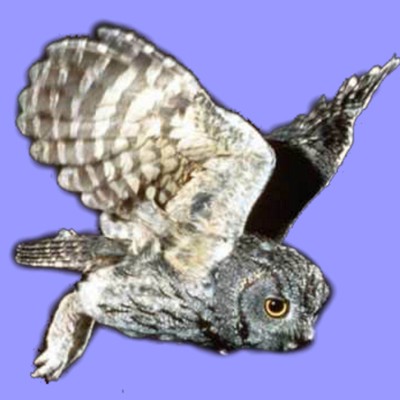Great Horned Owl, Bubo virginianus
The Great Horned Owl is sometimes called “cat owl” because of its catlike ears, eyes and shape of head. Like other night-active birds of prey, they have a highly developed auditory system. The great horned owl is highly recognizable for the feather tufts on its head that resemble cat ears.
The great horned owl has a large geographic range. It is found throughout the American continent; from Tierra del Fuego to the north of the United States. The species usually nests in tree holes or occupy the abandoned nests of other birds.
 Main characteristics
Main characteristics
The Great Horned Owl is covered by heavy, striped feathers in brown colours. It measures approximately 0,5m in length and has a wingspan of nearly 1,5m from tip to tip. It has a short, curved beak and powerful and strong claws. Like all owls of the Bubo genus, it has a sharp vision and an extremely sensitive auditory system, which enables it to locate its prey even in absolute darkness. This bird of prey spends most of its day time in the nest, becoming active during the night. Within its range, the Great Horned Owl can be found in dense woodlands of hardwoods and conifers, along cliffs and rocky canyons, and in forest openings.
The courtship of the Great Horned Owl usually begins in late January or early February. The mating rituals of the owl include the singing of love songs between the female and male. The eggs usually number 2-3, and rarely as many as 5. The male and the female will both incubate the eggs, which will hatch in approximately 30 days. The Great Horned Owl is a very protective parent, guarding the young until they mature fully and can leave the family approximately one or two months after hatching.
The Great Horned Owl prefers to feed on small mammals, such as rabbits, woodchucks, mice, rats, squirrels, and skunks. It is also known to feed on birds such as ducks, game birds, quails, and occasionally geese or turkeys.
Great Horned Owl, Bubo virginianus
Facts:
How are they? The Great Horned Owl is a medium-large nocturnal raptor. It has a short, curved beak, a striped plumage and two ear tufts in shape of ears on each side of the head.
Where do they live? In savannahs, forests and mountain areas.
How is the species geographically distributed? From Tierra del Fuego up to the North of the United States of America.
What do they feed on? Small mammals, reptiles, other birds and even fish.


